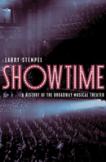Curtain Call
To begin a book on the history of Broadway musical theater with Stephen Sondheim could hardly be construed as novel or surprising. After all, Sondheim is arguably the finest living composer and lyricist of this captivating category of theater. Being a fervent fan of the genre in general and of Sondheim in particular, I was glad Larry Stempel begins his history with this master, who turned 80 last year. At a gala birthday celebration at Carnegie Hall, upon ascending the stage to thunderous applause, a clearly choked-up Sondheim, quoting Alice Roosevelt, said simply: “First you’re young, then you’re middle-aged, and then you’re wonderful.”
Stempel’s labor of love, coming to birth after a gestation period of 30 years and more, is just that: wonderful. This associate professor of music at Fordham University does just what he says he will do. He writes a history. “It’s the fragment, not the day.... Not the building but the beam, Not the garden but the stone, Only cups of tea and history” (“Someone in a Tree,” from Sondheim’s “Pacific Overtures”).
Working between the extreme of a strict linear narrative and a chronicle—“of conceptually determining or even schematizing information, and of conceptual laxity in organizing it”—Stempel, as best he understands, has “sought to shape [a] history...in ever-shifting combinations of data and ideas as these correspond to changing cultural pressures over time.” In short, as his own language suggests, Stempel scripts “a scholarly reassessment of the history of the medium.”
At the start of Showtime Stempel cites a Czech theorist, Ivo Osolsobe, who defines the musical in his Semiotics of the Musical Theatre as “the theatre which speaks, sings, and dances” or, more fully, “talking (almost always); singing (most often accompanied by unseen instruments); and dancing (generally mixed and interspersed with other kinds of movement).”
Stempel’s book is knowledgeable and engaging, containing information with which many fans are familiar: the topsy-turvy stuff of Gilbert and Sullivan, the double songs of Irving Berlin (e.g., “An Old Fashioned Wedding” from “Annie Get Your Gun”), Cole Porter matching specific styles to specific stars, Rogers and Hammerstein blurring the “functional distinction between spoken dialogue and musical numbers—book and score”—and Off-Broadway plays as well.
Broadway devotees will appreciate the book’s eye-catching illustrations: posters and playbills as well as kernels of dialogue, lyrics and musical scores. There are also memorable anecdotes, like David Merrick’s shameless announcement of Gower Champion’s death at the opening-night curtain call of “42nd Street” and Liza Minnelli’s lip-syncing on stage to pre-recorded songs in “The Act.”
As both a fan of theater and a scholar, the author ably steers “the course between the Scylla of outright advocacy and the Charybdis of mere description” in constructing “a history of the Broadway musical at once coherent and critical.” The historian tells us he draws on a wide variety of primary materials and archival holdings of original sources (prompt books, typescripts, song sheets, costumer renderings, personal interviews he conducted as well as a plethora of secondary sources). This wealth of information and insight adds up to a compelling history.
The book moves from our country’s cultural transition from dependence on French, German and English theater to the beginnings of a native style, finding its footing in Uncle Tom’s Cabin (awakening sympathy and feeling for the African race) and The Black Crook. Then it is on to an examination of our gilded age and its variety shows, the rising immigrant experience, burlesque and the black musical influence. Then Stempel covers the golden age of American light opera and operetta, and the rise of the truly American musical, with its native wit and the likes of Cohan and Jolson, among others.
Then there are the even more ambitious undertakings, American opera as it were: “Porgy and Bess” (the Gershwins), “Most Happy Fella” (Loesser), “Fanny” (Rome), “West Side Story” (Bernstein). As Stempel the historian points out, the Broadway musical is nothing if not diverse theater entertainment: “Guys and Dolls” (Burrows and Loesser), “The Pajama Game” (Abbott and Bissell, Adler and Ross), “The Music Man” (Willson), “Gypsy” (Laurents, Sondheim and Styne), “How To Succeed In Business Without Really Trying” (Burrows, Weinstock, Gilbert and Loesser). The list goes on.
In the midst of this burgeoning of the “great American showshop” was at least one, singular sensation—the producer George Abbott, whose roster of authors, songwriters, stagers, performers and entrepreneurs reads like a who’s who in musicals of the age: the likes of Walker, Comden and Green, Robbins, Styne, Fosse, Sondheim, Kander and Ebb, among others. There was also the satire of Harburg, notably, “Finian’s Rainbow.”
Of course no history of the Broadway musical would be complete without a thorough discussion of the “concept” musical and how it changed the musical theater’s landscape, if not forever, certainly for a not insignificant time. Here the names Harold Prince and Stephen Sondheim are most notable. Stempel also cites the influences of the different directors, who caught and taught all that was physically possible on the musical stage.
Since the history continues to unfold, Stempel discusses the current definition of the “revival” and its three contemporary trends: the reconstructed (e.g., “Encores!”) the respected (“Show Boat”) and the reinvented (“Crazy for You”). He also examines the rise of the antimusical (“Hello Again”) alongside the old-fashioned, with its modern “mix of nonsense, prurience, and pizzazz” (“The Producers”) and those antimusicals that reached wider audiences (“Jelly’s Last Jam”). Stempel concludes with what he calls Sondheim’s children, musicals based on proven material (“Wicked”), original tales (“Avenue Q”) and Sondheim as touchstone (“Rent”).
Stempel’s big book may be more than the occasional fan of the Broadway musical wants or wishes to read. For the fervent fan, on the other hand, Showtime is refreshingly rewarding, bursting with keen analysis—a captivating keepsake that theater-goers will devour.
This article also appeared in print, under the headline “Curtain Call,” in the April 11, 2011, issue.








